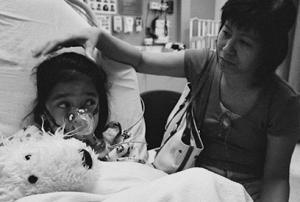
Image adapted from Daryl Davis under a Creative Commons license: BY.
The purpose of this sequence is to teach the aspects of basic science related to the respiratory system, building on the anatomy, physiology, and biochemistry taught in year 1. Clinical examples of applied basic science are based on common lung diseases including: pneumonia, emphysema, asthma, cancer, trauma, ARDS, and respiratory diseases of the newborn.
Sequence Coordinators:
Paul J. Christensen, M.D.
Tom Sisson, M.D.
John Younger, M.D.
dScribe: Cathy Mummert
Syllabus
Overview
The purpose of this course sequence is to teach the aspects of basic science related to the respiratory system, building on the anatomy, physiology, and biochemistry taught in year 1. Course faculty are drawn from the basic sciences of Pathology and Pharmacology, and the clinical sciences of Internal Medicine, Surgery, Pediatrics, and Radiology. Clinical examples of applied basic science are based on common lung diseases: pneumonia, emphysema, asthma, cancer, ARDS, and respiratory diseases of the newborn. The specific goals for students are:
- To learn respiratory physiology and pathophysiology in normal subjects and patients with lung disease; including interpretation of respiratory function tests, blood gases, pulmonary and systemic hemodynamic monitoring, and correlation of symptoms and physical findings with pathophysiologic events.
- To learn normal and abnormal gross and microscopic anatomy of the chest and lung including tissue pathology, physical examination, radiologic examination, surgical anatomy, embryology, and special examinations like bronchoscopy.
- To be able to classify and describe respiratory diseases based on etiology, pathology, pathophysiology, and clinical presentation.
- To gain the knowledge base for material which will be taught in the third year, including:
- Basic approach to evaluation of respiratory disease based on anatomy, physiology, and biochemistry.
- Basic approach to the management of respiratory diseases including applied physiology, pharmacology and pathology, airway access, and mechanical ventilation.
Teaching Methods
The lectures, small group sessions, and pathology laboratories are designed to focus on broad topics (pulmonary mechanics, gas exchange, lung cancer, pneumonia, etc.). Most mornings will begin with an optional 30 minute session led by the sequence coordinators. This time will be used to provide illustrative examples, to clarify points from the previous day, to explore potential exam questions, etc.
Pathology laboratories will be held on Friday, September 12th , Tuesday, September 18th, and Friday, September 19th from 1- 3:00.
On Thursday afternoon, September 18th, the entire class will visit the hospital in small groups. Each student will visit five stations devoted to: pulmonary function testing, bronchoscopy, intubation, radiology, mechanical ventilation, and intensive care.
Two small group case discussions will be held on Monday afternoon, September 15th, and Monday morning, September 22nd. These sessions are led by faculty from Pulmonary Medicine or Surgery, and provide an opportunity to cement your understanding of some of the fundamental concepts.
Textbooks and Reading Material
The bulk of the material for which you are responsible is contained in the course syllabus. For many of the lectures, the slides will be available on the M2 2008-2009 site on the CTools Portal. As we went to press, there still was a lecture (or two) for which the handout was not available for copying with the remainder of the syllabus. These will be given out the day of the lecture. The syllabus includes a glossary of terms, normal and abnormal values for oxygen kinetics, pulmonary mechanics and gas exchange.
There are two recommended (not required) text books for this sequence. West’s Pulmonary Pathophysiology, and Weinberger’s Principles of Pulmonary Medicine. As the title suggests, West’s text emphasizes pathophysiology. Weinberger’s text contains more information about the clinical presentation and treatment of common disease processes. We believe they will supplement the lectures nicely and provide an alternative approach.
Required Experiences
In the Respiratory sequence there are small group sessions that are required attendance. In the RARE circumstance where a student cannot attend, the student must contact their class counselor in advance (or as soon as possible in an emergency) to request a deferral. (Please do NOT contact sequence directors with requests for or explanations of deferrals.) Absences will be approved or denied by class counselors based on the same guidelines used for Quiz and Exam deferrals. Should you obtain a deferral from your class counselor, make up instructions for the required experiences (found below) should be followed.
Remediation assignments will be assigned by the Course Directors on a case-by-case base. Assignments will be due to the Course Directors 48 hours after the end of the sequence.
Examinations and Grading
Grades will be determined based on a performance on the written (computer based) final, the lab final, and an open book homework assignment. The approximate weighting is as follows:
10% of the final grade is based on lab exam
80% of the final grade is based on the final exam
10% of the final grade is based on the open book homework assignment
Grading in the Respiratory sequence will comply with M2 grading policies. A pass/fail system will be used, and a cumulative grade of 75% or higher will be required for a passing score. Cumulative grades of 74.99% or lower will be assigned a failing grade.
Instructors
Sequence Coordinators
Paul Christensen, MD, Department of Internal Medicine
Tom Sisson, MD, Department of Internal Medicine
John Younger, MD, Department of Emergency Medicine
Learning Outcomes
The specific goals for students are:
- To learn respiratory physiology and pathophysiology in normal subjects and patients with lung disease; including interpretation of respiratory function tests, blood gases, pulmonary and systemic hemodynamic monitoring, and correlation of symptoms and physical findings with pathophysiologic events.
- To learn normal and abnormal gross and microscopic anatomy of the chest and lung including tissue pathology, physical examination, radiologic examination, surgical anatomy, embryology, and special examinations like bronchoscopy.
- To be able to classify and describe respiratory diseases based on etiology, pathology, pathophysiology, and clinical presentation.
- To gain the knowledge base for material which will be taught in the third year, including:
- Basic approach to evaluation of respiratory disease based on anatomy, physiology, and biochemistry.
- Basic approach to the management of respiratory diseases including applied physiology, pharmacology and pathology, airway access, and mechanical ventilation.
Reading List
Recommended Textbooks
There are two recommended (not required) text books for this sequence. West’s Pulmonary Pathophysiology, and Weinberger’s Principles of Pulmonary Medicine. As the title suggests, West’s text emphasizes pathophysiology. Weinberger’s text contains more information about the clinical presentation and treatment of common disease processes. We believe they will supplement the lectures nicely and provide an alternative approach.

Image adapted from Daryl Davis under a Creative Commons license: BY.
| Document Title | Creator | Downloads | License |
|---|---|---|---|
|
Pathology Labs 1-3 |
Gerald Abrams
Stephen Ramsburgh
|
| Document Title | Creator | Downloads | License |
|---|---|---|---|
|
09.12.08(a): Gas Exchange |
John Younger
|
||
|
09.12.08(b): An Introduction to Blood Gas Analysis |
John Younger
|
||
|
09.16.08: Pulmonary Vascular Disease |
Thomas Sisson
|
||
|
09.17.08(a): Sepsis |
John Younger
|
||
|
09.17.08(b): Introduction to Mechanical Ventilation |
Thomas Sisson
|
||
|
09.17.08(c): Acute Respiratory Distress Syndrome |
Thomas Sisson
|
||
|
09.23.08: Cystic Fibrosis |
Richard Simon
|
||
|
09.23.08: NewbornRespiratory Disease |
Robert Schumacher
|
||
|
10.18.10: Lung Cancer |
Douglas Arenberg
|
| Document Title | Creator | Downloads | License |
|---|---|---|---|
|
2006 Daily Schedule: M2 Respiratory |
Dept. Staff
|
||
|
2007 Daily Schedule: M2 Respiratory |
Dept. Staff
|
||
|
2008 Daily Schedule: M2 Respiratory |
Dept. Staff
|
||
|
2009 Daily Schedule: M2 Respiratory |
Dept. Staff
|



